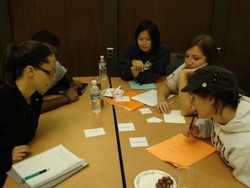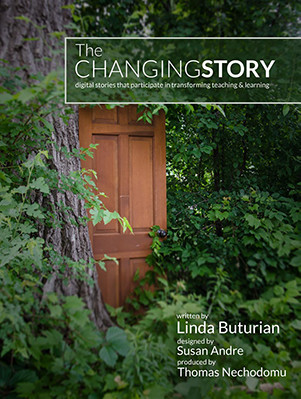
This blog focuses on my scholarship in my five research projects: learning assistance and equity programs, student peer study group programs, learning technologies, Universal Design for Learning, and history simulations. And occasional observations about life.
Assessing the impact of a muilti-disciplinary Peer Led-Team Learning program on undergraduate STEM education.
 Carlson, K., Celotta, D. T., Curran, E., Marcus, M., & Loe, M. (2016). Assessing the impact of a muilti-disciplinary Peer Led-Team Learning program on undergraduate STEM education. Journal of University Teaching & Learning Practice, 13(1), article 1. Retrieved from http://ro.uow.edu.au/cgi/viewcontent.cgi?article=1570&context=jutlp.
Carlson, K., Celotta, D. T., Curran, E., Marcus, M., & Loe, M. (2016). Assessing the impact of a muilti-disciplinary Peer Led-Team Learning program on undergraduate STEM education. Journal of University Teaching & Learning Practice, 13(1), article 1. Retrieved from http://ro.uow.edu.au/cgi/viewcontent.cgi?article=1570&context=jutlp.
There has been a national call to transition away from the traditional, passive, lecture-based model of STEM education towards one that facilitates learning through active engagement and problem solving. This mixed methods research study examines the impact of a supplemental Peer-Led Team Learning (PLTL) program on knowledge and skill acquisition for students in introductory biology, chemistry, calculus and applied statistics courses. Results indicate program participants reliably outperform their matched pairs in courses that emphasize quantitative reasoning. Moreover, program participants report acquiring important insights about learning, collaboration, and engagement in undergraduate STEM education. These results are consistent with previous findings on PLTL and also provide insight into the roles of course context and student population on program outcomes.
To download the entire annotated bibliography of over 1,100 references to postsecondary peer cooperative learning programs, click on the following web link, http://z.umn.edu/peerbib
2016 Annotated Bibliograpy of Postsecondary Peer Cooperative Learning Programs Updated

This annotated bibliography does not attempt to be inclusive of this broad field of literature concerning peer collaborative learning. Instead, it is focused intentionally on a subset of the educational practice that shares a common focus with increasing student academic achievement and persistence towards graduation.
The seven student peer learning programs included in this bibliography meet the following characteristics: (a) the program must have been implemented at the postsecondary or tertiary level; (b) the program has a clear set of systematic procedures for its implementation that could be replicated by another institution; (c) program evaluation studies have been conducted and are available for review; (d) the program intentionally embeds learning strategy practice along with review of the academic content material; (e) the program outcomes include increased content knowledge, higher final course grades, higher pass rates, and higher college persistence rates; and (f) the program has been replicated at another institution with similar positive student outcomes. From a review of the professional literature, six programs emerged: (a) Accelerated Learning Groups (ALGs), (b) Emerging Scholars Program (ESP), (c) Peer Assisted Learning (PAL), (d) Peer-Led Team Learning (PLTL), (e) Structured Learning Assistance (SLA), (f) Supplemental Instruction (SI), and (g) Video-based Supplemental Instruction (VSI). As will be described in the following narrative, some of the programs share common history and seek to improve upon previous practices.Other programs were developed independently.
Regrets for scholarship I have overlooked. Please send me items you think should be included in the next edition. Happy reading.
Free eBook for teachers and students to create digital stories
 The Changing Story: Digital stories that participate in transforming teaching & learning by Linda Buturian http://www.cehd.umn.edu/the-changing-story/ Free download as iBook or ePub formats for other devices through this website.
The Changing Story: Digital stories that participate in transforming teaching & learning by Linda Buturian http://www.cehd.umn.edu/the-changing-story/ Free download as iBook or ePub formats for other devices through this website.
If you are interested in having your students create digital stories or creating them as part of your learning activities, I recommend the following free eBook. Linda is a colleague of mine in our academic department at UMN. I have used principles from this book for digital stories that my students have constructed. It is a powerful experience for those who create them as well as everyone who views them.
This truly is a "must read" if you are interested in digital storytelling. Rather than just focusing on shallow techniques to quickly use the latest app to produce a video, the author takes us on the journey through the eyes of students and teachers why this approach is such a powerful and transformative learning experience. This experience occurs for both those who watch as well as those who create them. I enjoyed the embedded video clips from the teachers and samples of student-produced work. Plus the writing style of the author is accessible, enjoyable, and nuanced. Don't miss this book just because it is free.
Description by the author: “The Changing Story gives you assignments, resources, and examples to use in your teaching and learning. It will also help you think of ways digital stories can be used in your teaching, and help students harness the power of visual storytelling. The Changing Story is a free ebook that is downloadable and licensed with Creative Commons.”
2016 David Arendale's Directory of iPad Apps for Classroom and Personal Use
 2016 David Arendale's Directory of iPad Apps is available for downloading.
2016 David Arendale's Directory of iPad Apps is available for downloading.
<Click on this link to download the 2016 directory.>
The Apple iPad continues to grow with the number of users and the enormous number of apps available for downloading, many of which are free. The latest count is approaching two million. My directory contains my favorite 300 I use personally and with my work as a college history professor. I am excited to see how I experience them on the iPad Pro that I will be purchasing in December.
David Arendale 2015 Guide to iPad Apps
 David Arendale 2015 guide to iPad Apps
David Arendale 2015 guide to iPad Apps
<Click here to download the directory>
The Apple iPad continues to grow with the number of users and the enormous number of apps available for downloading, many of which are free. The latest count is over 1.2 million. My directory contains my favorite 300 I use personally and with my work as a college history professor.
MAEOPP Center 2015 Best Education Practices Directory
 MAEOPP Center 2015 Best Education Practices Directory
MAEOPP Center 2015 Best Education Practices Directory
Copyright ©2015 by Mid-America Association of Educational Opportunity Program Personnel (MAEOPP) and the University of Minnesota by its College of Education and Human Development, Department of Postsecondary Teaching and Learning, Minneapolis, MN.
MAEOPP is pleased to release the 2015 directory of peer-reviewed education practices approved by the MAEOPP Center for Best Education Practices. Each practice has undergone a rigorous external review process. This directory contains those approved at the promising and validated levels. Readers can use this publication as a guide for implementing the evidence-based education strategies contained within it. Detailed information about the education practice purposes, educational theories that guide the practice, curriculum outlines, resources needed for implementation, evaluation process, and contact information are provided by the submitters of the practice who have practical experience implementing it. Consider using them with current programs and in grant submissions that require evidence-based practices to improve student success.
The thirteen practices approved thus far by the MAEOPP Center represent each of the five major TRIO grant programs: Educational Talent Search, Upward Bound, Educational Opportunity Centers, Student Support Services, and Ronald E. McNair Postbaccalaureate Achievement Programs. One practice is from a GEAR UP program. For readers unfamiliar with TRIO programs, a short history is provided. While the education practices come from TRIO and GEAR UP programs, they could be adapted for use with nearly any student academic support and student development program. These programs are incubators of best practices to serve the needs of historically underrepresented students and the general student population as well.
Facebook Addiction and GPA
Facebook is a tempting distraction. I have it open as a tab in my browser as I write this. And look, it’s showing that I have a new notification! I must see it, immediately. Facebook designed the site to make me feel that way. This doesn’t bode well for college students. If professionals, and even some professors, have a hard time resisting the lure of Facebook, then what chance do 18-year-olds have?
New research suggests that the kids may be all right. A study of Facebook activity and grade-point averages suggests that students may learn to regulate their use of Facebook, both as a distraction from coursework and in their free time, as they move through college. Reynol Junco, an associate professor of education at Iowa State University, collected data from about 1,800 students at a four-year college. He found that students who spent a lot of time on Facebook while also trying to complete assignments tended to get worse grades.
The correlation, however, held true only for freshmen, sophomores, and juniors. Seniors tended to use Facebook less in general. For them, time spent on the site did not correlate negatively with GPA. “Seniors were less likely to post status updates than freshmen and sophomores, comment on content less than the other class ranks, use Facebook chat less than freshmen and sophomores, post photos less than juniors, tag photos less than freshmen and juniors, and view videos less than all the other class ranks,” Mr. Junco wrote in a paper published this month in the Journal of Applied Developmental Psychology. It could be that freshmen are simply not as good at resisting the urge to use Facebook when they should be working, and that they get better at it as they get older.
Mr. Junco also pointed out that freshmen are scrambling to find their social footing in a strange new place while clinging to the relationships they’ve recently left behind. “Freshmen must not only adapt to a new academic environment, but also a social one in order to be successful,” he wrote. The self-regulation skills of individual students no doubt play a role at any age. Mr. Junco’s snapshot is of four groups of students, not a single group evolving over time. But he hopes the study will at least help higher-education professionals move past their own antipathy to Facebook use. An “abstinence only” approach, Mr. Junco said, is more likely to “alienate students and not allow for the leveraging of the important social affordances of Facebook in support of the first-year transition process.”

